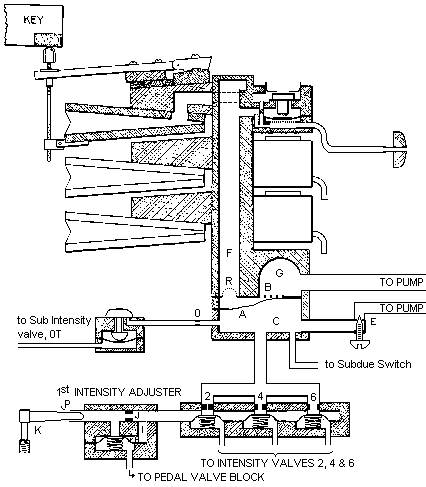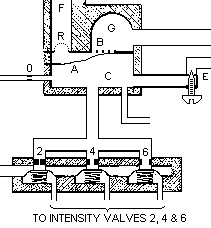| You Are Not Logged In | Login/Get New Account |
|
Please Log In. Accounts are free!
Logged In users are granted additional features including a more current version of the Archives and a simplified process for submitting articles. |
|
MMD
 Gallery
Gallery
 Tech
Tech
 Ampico
Ampico
 amp11.htm
amp11.htm
|
|
Spring Fundraising Drive In Progress. Please visit our home page to see this and other announcements:
https://www.mmdigest.com Thank you. --Jody
|

Three of these openings are arranged longitudinally along the bottom of chamber C and one connects into the side of this chamber. For the purpose of making this figure perfectly clear, all parts are shown in transverse section, except the openings and valves which are diagrammatic and are shown in longitudinal section. The three openings and pouch valves are actually built into the bottom board of the regulator and not isolated as shown. Disregarding for the moment the parts of the apparatus at H and I of the 1st Intensity adjuster, which are described on page 27 under the heading of Loud Pedal Valve Block, atmosphere enters tube P around the tapered pin K, flows through J and then through 2, 4 and 6, any or all into chamber C. With 2, 4 and 6 open and 0 closed, the suction maintained in chamber C produces the First Intensity.  The closing of 2, 4 and 6 singly, or in combination, reduces
the atmosphere influx to chamber C and produces different degrees
of suction in it.
The closing of 2, 4 and 6 singly, or in combination, reduces
the atmosphere influx to chamber C and produces different degrees
of suction in it.
These different degrees of suction in the chamber C cause the regulator pouch A to open different amounts and produce the same suctions in the wind chest F. This gives the different steps in the intensity scale. With 2, 4 and 6 and 0 open, the suction maintained in chamber C produces an intensity which is lower than the No. 1 intensity. This is called the "sub" intensity and is used to obtain extreme pianissimo effects. The pouches controlling 2, 4 and 6, as well as the opening 0, are operated by valves in the expression valve block. These are described on page 12. All of these openings -- 0, 2, 4, and 6 -- are of fixed size, each having its proper and constant effect upon the intensity scale. They are manufactured very accurately of a material which insures against any variation, and must never be altered. Two regulators as described above are used -- one for the Bass, and one for the Treble. The entire regulation is accomplished by the balance of pressures, established on both sides of the regulator pouch by means of the relationship between the respective fixed orifices. There are no heavy or cumbersome mechanical parts to be moved during the process of regulation when action suction must be accurately maintained, or instantly changed. All of this is accomplished by the slight movement of a thin rubber cloth pouch, the weight of which is only a few thousandths of the weight of the moving parts of the best regulating system heretofore employed. It is due to is lightness and simplicity that the accuracy and effectiveness of regulation in the New Ampico is infinitely greater than has been achieved by any regulating system previously used.
Reproduced from page 10 and 11, The Ampico Service Manual 1929, Copyright 1929 by American Piano Company |
|
|
|
|
|
|
|
|
|
CONTACT FORM: Click HERE to write to the editor, or to post a message about Mechanical Musical Instruments to the MMD Unless otherwise noted, all opinions are those of the individual authors and may not represent those of the editors. Compilation copyright 1995-2025 by Jody Kravitz. Please read our Republication Policy before copying information from or creating links to this web site. Click HERE to contact the webmaster regarding problems with the website. |
|
|
||||||
|